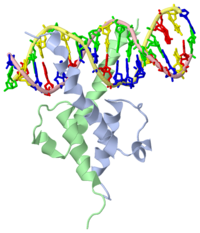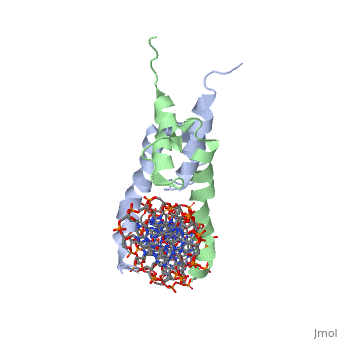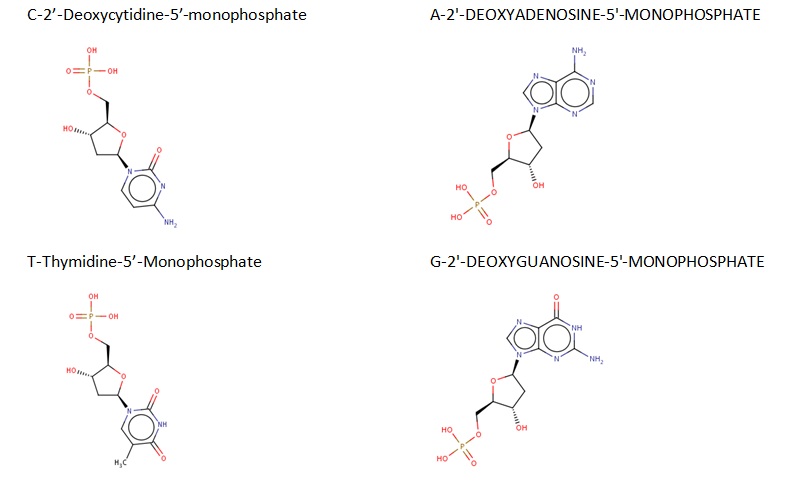Pho4 bHLH Protein
From Proteopedia
| |||||||||
| 1a0a, resolution 2.80Å (default scene) | |||||||||
|---|---|---|---|---|---|---|---|---|---|
| |||||||||
| |||||||||
| Resources: | FirstGlance, OCA, RCSB, PDBsum | ||||||||
| Coordinates: | save as pdb, mmCIF, xml | ||||||||
Contents |
PHOSPHATE SYSTEM POSITIVE REGULATORY PROTEIN PHO4/DNA COMPLEX
Introduction
The complete nucleotide sequence of Saccharomyces cerevisiae chromosome VI (270 kb) has revealed that it contains 129 predicted or known genes (300 bp or longer).(1)
One of them is PHO4 gene, which positively controls the expression of phosphatase genes, has been isolated by complementation of a pho4 mutation. The isolated DNA directed integration at the chromosomal PHO4 locus. The nucleotide sequence of PHO4 has a coding region of 930 nucleotides, flanked by sequences with typical transcription initiation and termination signals. The 5' region has characteristics of low-expression promoters and carries several uncommon elements, whose significance is not known. The predicted primary structure of the PHO4 protein, of 309 residues, does not show sequence elements typical of DNA-binding proteins. The transcription of PHO4 is independent of inorganic phosphate. Like other regulatory genes, PHO4 is transcribed at a very low level and the translation of its message uses preferentially several codons which are not employed for highly expressed genes. (2)
The PHO4 gene encodes a positive regulatory factor involved in regulating transcription of various genes in the phosphatase regulon of Saccharomyces cerevisiae. Besides its own coding region, the 1.8-kilobase PHO4 transcript contains a coding region for a mitochondrial protein which does not appear to be translated. Four functional domains were found in the PHO4 protein, which consists of 312 amino acid (aa) residues as deduced from the open reading frame of PHO4. A gel retardation assay with beta-galactosidase::PHO4 fused protein revealed that the 85-aa C terminus is the domain responsible for binding to the promoter DNA of PHO5, a gene under the control of PHO4. This region has similarities with the amphipathic helix-loop-helix motif of c-myc protein. Determination of the nucleotide sequences of four PHO4c mutant alleles and insertion and deletion analyses of PHO4 DNA indicated that a region from aa 163 to 202 is involved in interaction with a negative regulatory factor PHO80. Complementation of a pho4 null allele with the modified PHO4 DNAs suggested that the N-terminal region (1 to 109 aa), which is rich in acidic aa, is the transcriptional activation domain. The deleterious effects of various PHO4 mutations on the constitutive transcription of PHO5 in PHO4c mutant cells suggested that the region from aa 203 to 227 is involved in oligomerization of the PHO4 protein. (3)
Binding of transcription factors to DNA is a key regulatory step in the control of gene expression. DNA sequences with high affinity for transcription factors occur more frequently in the genome than instances of genes bound or regulated by these factors. Although several mechanisms have been identified that influence the specificity of transcriptional regulation, it is not known if these can explain the observed genome-wide pattern of binding or regulation for a given transcription factor.(4)
PHO4 transcription factor is a basic helix loop helix structure with 312 amino acid residues with 4 functional domains commonly found in S. cerevisiae(6). The amount of enviornmental inorganic phosphate regulates the activity of PHO4 binding (5). PHO4 is a regulatory protein active during phosphorylation. When phosphates are abundant PHO4 becomes phosphorylated by cyclin PHO80 and cyclin-dependent kinase PHO85, which causes PHO4 to become transported from nucleous to cytoplasm (5).
When there is limited amount of phosphate PHO4 is dephosphorylated and transported into the nucleous which activates the gene for transcription (5). The particular genes at which PHO4 activaes are PHO5, PHO81 and PHO84(2). A cooperative interaction between transcription factor PHO2 and PHO4 typically occurs in order to activate the PHO5 gene(5). Base flanking of PHO4 was compared to other bHLH structures such as MyoD, MAX, USF, E47 and CPF1(6). The binding angle degree of each structure may be a determining factor for specific dimer formation (6)
Other molecules such as nucleosomes and Cbf1 can cause PHO4 to not bind to promoter due to competition for the promoter site CACGTG (6).
In the PHO5 gene,Due to PHO4 binding disrupting nucleosome binding structure this can cause chromatin reorganization of the PHO5 and murine mammary tumor virus(or mouse mammary tumor virus) promoters(7). In order for MMTV to activate nucleosomes must be present, PHO4 can act as a way to inhibit the formation of nucleosome binding within this virus (7). MMTV is a retrovirus which is transmitted by infected mother to offspring via breast milk due to extra choromsome (8). The virus is typically integrated within the host DNA and is generally transported into the host via the gastrointestinal tract infecting the immune system(9). Dendritic cells are the first infected cells in the MMTV virus which then are transmitted to other cell types(9). When the virus infects dendritic cells they then become more mature and start migrating in response to chemokine macrophage inflammatory protein 3β(9).
The crystal structure of a DNA-binding domain of PHO4 complexed with DNA at 2.8 A resolution revealed that the domain folds into a basic-helix-loop-helix (bHLH) motif with a long but compact loop that contains a short alpha-helical segment. This helical structure positions a tryptophan residue into an aromatic cluster so as to make the loop compact. PHO4 binds to DNA as a homodimer with direct reading of both the core E-box sequence CACGTG and its 3'-flanking bases. The 3'-flanking bases GG are recognized by Arg2 and His5. The residues involved in the E-box recognition are His5, Glu9 and Arg13, as already reported for bHLH/Zip proteins MAX and USF, and are different from those recognized by bHLH proteins MyoD and E47, although PHO4 is a bHLH protein.
Crystal structure of PHO4 bHLH domain-DNA complex: flanking base recognition., Shimizu T, Toumoto A, Ihara K, Shimizu M, Kyogoku Y, Ogawa N, Oshima Y, Hakoshima T, EMBO J. 1997 Aug 1;16(15):4689-97. PMID:9303313
From MEDLINE®/PubMed®, a database of the U.S. National Library of Medicine.
Primary Sequence of Polypeptide
Pho4 contains DNA binding site is Chain C with Primary Sequence of DNA (5’-CTCACACGTGGGACTAG-3’)
Primary Sequence of Polypeptide
MKRESHKHAEQARRNRLAVALHELASLIPAEWKQQNVSAAPSKATTVEAACRYIRHLQQNGST
1-MET-LYS-ARG-GLU-SER-HIS-LYS-HIS-ALA-GLU-GLN-ALA-ARG-ARG-ASN-ARG-LEU-ALA-VAL-ALA-LEU-HIS-GLU-LEU-ALA-SER-LEU-ILE-PRO-ALA-GLU-TRP-LYS-GLN-GLN-ASN-VAL-SER-ALA-ALA-PRO-SER-LYS-ALA-THR-THR-VAL-GLU-ALA-ALA-CYS-ARG-TYR-ILE-ARG-HIS-LEU-GLN-GLN-ASN-GLY-end
About this Structure
The crystal structure of a DNA-binding domain of PHO4 complexed has DNA resolution of 2.8 A. This domain folds into a basic-helix-loop-helix (bHLH) motif with a long loop. The compact loop contains a short alpha-helical segment. This helical segment places a tryptophan residue into an aromatic cluster forming the compact loop.A homodimer is formed when PHO4 binds to DNA this complex has the ability to direct reading of both the core E-box sequence CACGTG and its 3'-flanking bases. The Arg2 and His5 are both able to recognize the 3'-flanking bases GG. The residues involved in the E-box recognition are His5, Glu9 and Arg13, as already reported for bHLH/Zip proteins MAX and USF, and are different from those recognized by bHLH proteins MyoD and E47, although PHO4 is a bHLH protein.
1a0a is a 4 chain structure with sequence from Saccharomyces cerevisiae. Full crystallographic information is available from OCA.
Predicted functional partners of Pho4
•PH0 80
•PHO85
•PHO2
•PHO81
•MSN5
•PSE1
•SUA7
•SPT 15
•PHO4
•IN04
Sequence comparison to large number of mammalian and Drophilia BHLH proteins reveales similarity in the bHLH region.
Reference
- Shimizu T, Toumoto A, Ihara K, Shimizu M, Kyogoku Y, Ogawa N, Oshima Y, Hakoshima T. Crystal structure of PHO4 bHLH domain-DNA complex: flanking base recognition. EMBO J. 1997 Aug 1;16(15):4689-97. PMID:9303313 doi:10.1093/emboj/16.15.4689
1. Murakami Y., Naitou M., Hagiwara H., Shibata T., Ozawa M., Sasanuma S., Sasanuma M., Tsuchiya Y., Soeda E., Yokoyama K., Yamazaki M., Tashiro H., Eki T."Analysis of the nucleotide sequence of chromosome VI from Saccharomyces cerevisiae." Nat. Genet. 10:261-268(1995) [PubMed: 7670463]
2. Legrain M., de Wilde M., Hilger F."Isolation, physical characterization and expression analysis of the Saccharomyces cerevisiae positive regulatory gene PHO4." Nucleic Acids Res. 14:3059-3073(1986) [PubMed: 3008105]
3. Ogawa Nobuo, Oshima Yasuji (May 1990). ‘’Functional Domains of a Positive Regulatory Protein, PHO4, for Transcriptional Control of the Phosphatase Regulon in Saccharomyces cerevisiae. Molecular and Cellular Biology. 10 (5): 2224-2236. PMC 360570. PMID 2183025.
4. Zhou Xu and O’Shea Erin K. (June 2011). ‘’ Integrated approaches reveal determinants of genome-wide binding and function of the transcription factor Pho4. Molecular Cell. 42 (6): 826-836. PMC 3127084. NIHM 305276.
5. Zhou X, O’Shea E (2011) Integrated approaches reveal determinants of genome-wide binding and function of the transcription factor PHO4. Mol Cell 42(6): 826-836
6. Shimizu T, Toumoto A et. al. (1997) Crystal Structure of PHO4 bHLH domain-DNA complex: flanking base recognition. The EMBO Journal 16(15): 4689-4697
7. Bergh F, Flinn E M. (2000) Comparision of Nucleosome Remodeling by Yeast Transcription Factor PHO4 and the Glucocorticoid Recptor. The Journal of Biological Chemistry 275(12): 9035-9042
8. Bittner, J. J. (1936). Some Possible Effects of Nursing on the Mammary Gland Tumor Incidence in Mice. Science 84 (2172): 162–162
9. Courreges C M, et. al. Critical Role of Dendritic Cells in Mouse Mammary Tumor Virus In Vivo Infection. Journal of Virology 81(8) 3769-3777




